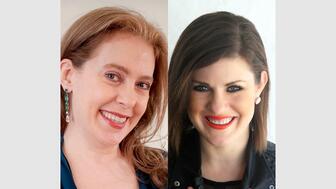The luxury goods company said founder Ippolita Rostagno will remain at the brand’s helm.
De Beers Piloting Blockchain Platform for Diamonds
Blockchain is a technology that’s poised to transform industries in the coming years, and De Beers wants diamonds to be one of them.

Last week, the diamond miner and marketer announced it has launched a pilot blockchain program for diamonds in partnership with BCG Digital Ventures, a subsidiary of Boston Consulting Group that’s investing heavily in blockchain.
Best known as the technology behind bitcoin, blockchain is a secure digital ledger that is decentralized, meaning it exists across multiple computers and servers and is not owned by any one user or organization.
For the diamond industry, De Beers’s David Prager said it will be used to register each interaction with a stone—like when it is cut at factory or graded at a lab—that then becomes part of the “block” of information about that particular diamond as it passes through the supply chain.
Each block must be validated by the blockchain community before it is added to the digital ledger.
When “chained” together, these individual blocks will form a digital record for each diamond.
Though it is being developed by De Beers, Prager said the diamond blockchain will be accessible by all industry participants, but will not include lab-grown diamonds.
“This is a diamond blockchain to record a diamond’s journey as it passes through the full value chain,” he said. “It is not for other products, whether they be lab-grown, precious metals or simulants. This means that the diamond blockchain will be able to provide the industry and consumers with clear and unambiguous assurance that their diamond is natural.”
It will be governed by an independent, nonprofit organization, the details of which are still being worked out.
A key focus of the pilot program is making the blockchain compatible for a range of operating systems for computers and phones.
When asked which companies will shoulder the extra cost blockchain will bring to the supply pipeline, Prager said De Beers is making the initial investment in blockchain because it believes it’s important for the diamond industry and that, ultimately, the efficiencies it will create in the supply chain will reduce the cost of doing business for many users.
“We are very excited about this initiative and the benefits it could deliver across the diamond value chain, from producers through to retailers and consumers.”–De Beers Group CEO Bruce Cleaver
First, keeping track of stones from mine to market allows the people who sell them to comfortably say this diamond is what it’s being presented as—for example mined, not lab-grown—and comes from an area of the world currently free of conflict.
Secondly, having a product that is traceable is more attractive to banks, which have been exiting the industry in great numbers due to concerns about diamonds being tied to money laundering.
“We are very excited about this initiative and the benefits it could deliver across the diamond value chain, from producers through to retailers and consumers,” De Beers Group CEO Bruce Cleaver said. “We look forward to continuing to engage with industry stakeholders as we progress development of the platform over the coming months.”
De Beers said its pilot blockchain program involves a “small number of participants.” While it isn’t disclosing company names, it said the partners “span the diamond value chain” and do include some sightholders.
A full launch is expected to take place later this year.
De Beers executives were in New York ahead of the Gem Awards and 24 Karat Club events last week pitching their blockchain project to the broader industry, including members of the U.S. Jewelry Council, a group of trade organizations that work together to ensure U.S. representation on responsible sourcing issues at the governmental and international levels.
Among those in attendance was Ronnie VanderLinden, president of the Diamond Manufacturers & Importers Association of America (DMIA), who said, “While this is still at an early stage of development, De Beers’s willingness to cooperate with and seek advice from all industry participants bodes well for successful development and implementation of this initiative. We look forward to continuing to work with them as it develops so we can make sure our members stand to see maximum benefit.”
De Beers has launched a website specifically for blockchain, which includes a section where visitors can sign up to receive updates as the project moves along.
While the miner and marketer works on developing a blockchain specifically for diamonds, a separate effort is underway to apply the technology to the colored gemstone supply chain.
Swiss gem lab Gübelin announced earlier this month that it is working with technology company Everledger to develop a program that will trace colored gemstones from mine to market, which it says will be the first of its kind.
The Latest

Laura Burdese, who joined the Italian luxury brand in 2022, will take on the role in July.

The National Jeweler editors revisit the most noteworthy industry happenings and design trends from 2025.

How Jewelers of America’s 20 Under 40 are leading to ensure a brighter future for the jewelry industry.

Need a gift for the cat lover who has everything? Look no further than our latest Piece of the Week.


It purchased the “Grosse Pièce,” an ultra-complicated Audemars Piguet pocket watch from the ‘20s, for a record-breaking price at Sotheby’s.

The lab-grown diamond grower now offers custom engagement and fashion jewelry through its Kira Custom Lab Jewelry service.

Roseco’s 704-page catalog showcases new lab-grown diamonds, findings, tools & more—available in print or interactive digital editions.

Chandler got his start at Michelson Jewelers and has served as DCA president and CEO since 2001. He will retire at the end of the month.

The boutique is slated to open this week inside Terminal 8, offering pre-owned Rolex watches and more to international travelers.

Sponsored by Digital Monitoring Products

The special-edition egg pendant ingested in a New Zealand jewelry store was recovered after a six-day wait.

Associate Editor Natalie Francisco plays favorites with Piece of the Week, selecting a standout piece of jewelry from each month of 2025.

The “Love and Desire” campaign is inspired by the magic that follows when one’s heart leads the way, said the brand.

Two awardees will receive free tuition for an educational course at the Swiss lab, with flights and lodging included.

Berta de Pablos-Barbier will replace Alexander Lacik at the start of January, two months earlier than expected.

Sotheby’s held its first two jewelry sales at the Breuer building last week, and they totaled nearly $44 million.

Winners will receive free registration and lodging for its fourth annual event in Detroit.

Here are six ideas for making more engaging content for Instagram Reels and TikTok, courtesy of Duvall O’Steen and Jen Cullen Williams.

The honorees include a notable jewelry brand, an industry veteran, and an independent retailer.

Carlos Jose Hernandez and Joshua Zuazo were sentenced to life without the possibility of parole in the 2024 murder of Hussein “Sam” Murray.

Yood will serve alongside Eduard Stefanescu, the sustainability manager for C.Hafner, a precious metals refiner in Germany.

The New Orleans jeweler is also hosting pop-up jewelry boutiques in New York City and Dallas.

Set in a Tiffany & Co. necklace, it sold for $4.2 million, the highest price and price per carat paid for a Paraíba tourmaline at auction.

The jeweler’s “Deep Freeze” display showcases its iconic jewelry designs frozen in a vintage icebox.

Take luxury gifting to new heights this holiday season with the jeweler’s showstopping 12-carat sphene ring.

This year's theme is “Unveiling the Depths of the Ocean.”

























